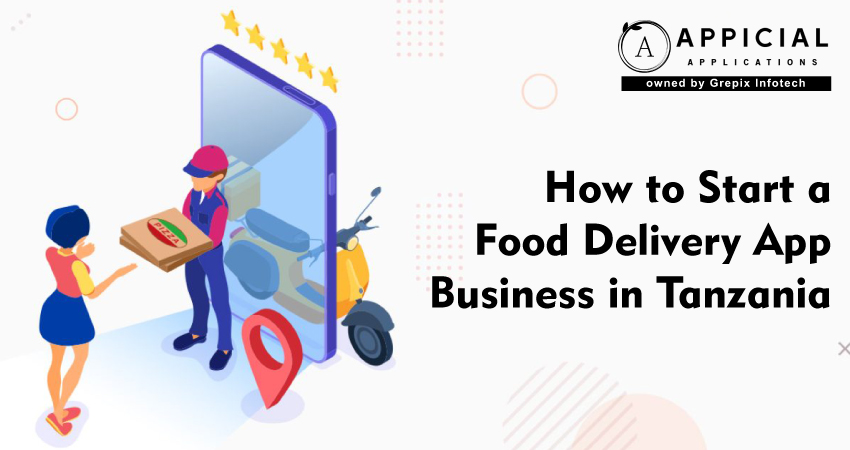
How to Start a Food Delivery App Business in Tanzania
Tanzania is changing, and fast.
You can see it in the way people move, shop, and eat. Life is busy. Traffic is worse. People want things done quicker, easier. Food, especially, is something more and more people want delivered.
Ten years ago, ordering food meant calling a restaurant (if they had a phone) and hoping someone picked up. Today? You just open an app. Tap a few buttons. And wait. That’s the experience people want.
And here’s the thing: it’s not just big companies like Grubhub delivery or DoorDash food delivery leading this. In countries like Tanzania, there’s still huge room for local startups to make their mark.
If you’re thinking of building a food delivery app, now is the time. There’s demand, there’s tech, and there’s opportunity.
But you’ll need more than just an app. You need a plan, and this guide’s here to walk you through it.
There has never been a better moment to launch your own delivery app because Tanzania's food delivery market is rapidly evolving. More Tanzanians are using apps to place meal orders as internet access grows and mobile money becomes more commonplace. Regardless of whether they live in smaller cities, Arusha, or Dar es Salaam, people are willing to pay for the convenience of eating healthily. Everything you need to know to launch a profitable food delivery app business is covered in detail in this blog. From understanding the local market to choosing the right features, tech stack, and pricing, it’s a full guide for anyone serious about launching in 2025. We also cover common challenges and how to overcome them, including logistics, payments, and customer trust. If you're looking to build something that works for the Tanzanian market, not just copy Western models like DoorDash or Grubhub, this guide is for you. And if you need a tech partner, Appicial Applications is ready to help.
Why Food Delivery Apps Are Worth Building in Tanzania?
Let’s start with one word: demand.
More people in Tanzania are using smartphones. Internet packages are cheaper than they used to be. Nowadays, mobile money is a part of daily life.
People are increasingly placing online food orders in places like Dar es Salaam, Arusha, Mwanza, and even smaller towns. Some are tired of cooking. Others just want to try something new.
Restaurants are catching on. Many of them want to reach more customers, but they don’t have the money or time to build their own apps. That’s where your idea comes in, a food delivery app that connects them to hungry users.
This isn’t about building the next DoorDash delivery app copy. It’s about building something that works well here, for the Tanzanian market.
What Features Should Your App Have?
A good food delivery app is simple. It shouldn’t confuse the user. It should get the food from the restaurant to the door, fast.
Here’s what your app needs:
For the customer:
- An easy way to sign up
- A map or list of restaurants nearby
- Full menus with photos and prices
- Mobile money and card payments
- Order updates in real time
- Estimated delivery time
- Option to rate and review
For the delivery driver:
- Notification when a new order is ready
- GPS navigation to the restaurant and then to the customer
- Earnings summary
- Status toggle (online/offline)
For the restaurant:
- Order dashboard
- Menu management (edit prices, mark items sold out)
- Sales tracking
And for you (the admin):
- User and order management
- Commission tracking
- Support tools (refunds, order issues, etc.)
That’s the basic framework. Once this is working, you can layer on more features later.
What Tech Will You Need?
Don’t let the word “technology” scare you. You don’t need to know how to code to build this, but you do need the right team.
Here’s what’s under the hood of a strong food delivery app:
Frontend (what people see):
- Flutter or React Native (for Android and iOS apps)
- Web frontend for restaurant and admin dashboards
Backend (how the app runs behind the scenes):
- Node.js, Django, or Laravel (these handle data and requests)
- MongoDB or PostgreSQL (to store data like orders, menus, and payments)
Tools and APIs:
- Google Maps for real-time delivery tracking
- Firebase for push notifications
- Payment integration: M-Pesa, Airtel Money, or card options
- SMS gateway for basic phones
It’s not about using the flashiest tools. It’s about using what works well, especially with Tanzanian infrastructure in mind.
What Are the Gaps in the Tanzanian Market?
You’re not starting from scratch, but you’re not entering a crowded market either. That’s a good place to be.
Here are a few areas where most local food ordering apps fall short, and where you can do better:
- Low coverage outside major cities: Focus on Tier-2 cities or university towns, untapped and hungry for service.
- Payment friction: Make M-Pesa and Airtel Money smooth. Don’t expect everyone to use cards.
- Restaurant onboarding: Many restaurant owners aren’t tech-savvy. Keep it simple for them.
- Delivery reliability: Riders canceling? Orders delayed? You need good logistics, not just tech.
- Customer service: People want answers fast. Build in support chat or at least responsive SMS.
Your app will gain traction if you can outperform the few players who are currently playing the game in solving these issues.
Also Read: Future of Urban Dining: food delivery app development in Algeria
How Much Will It Cost to Build?
This is the big question. And the honest answer is: it depends.
Here’s a ballpark:
MVP (basic app for Android):
- Core features only
- For customers and restaurants
- Timeline: 2–3 months
- Cost: $10,000 – $15,000
Full app (Android + iOS + admin panel):
- Includes real-time tracking: driver app, and analytics
- Timeline: 4–6 months
- Cost: $25,000 – $40,000+
Add some more for testing, servers, and launch marketing. If you're serious about this, treat it like building a real business, not a weekend side hustle.
What Can Appicial Applications Do for You?
This part is important.
You could try to build everything yourself. Or you could partner with a team that’s done it before.
At Appicial Applications, we don’t just write code. We help launch businesses. We’ve built delivery apps for clients across different continents, including African markets.
We get the challenges, patchy internet, mobile money quirks, and untrained drivers. And we build around them.
Here’s what you get when you work with us:
- Custom-built apps, not just templates
- Fast launches (MVPs in 8–10 weeks)
- Clean admin dashboards
- Local payment integrations
- Scalable architecture, built to grow with you
- Support after launch
Whether you're starting with a simple Android app or aiming for a full platform like DoorDash delivery app, we’ll walk with you every step.
Final Thoughts
You don’t need a Silicon Valley budget to start a food delivery app business in Tanzania. What you do need is a clear plan, a solid tech team, and an understanding of your local market. If you can bring all that together, you’ll be ahead of most startups in the space.
Tanzania is ready. The demand is growing. People are looking for convenience, and you can be the one to offer it.
Let’s make that happen.
At Appicial Applications, we specialize in helping entrepreneurs and businesses turn their food delivery dreams into reality. As a leading food delivery app development company, we’ve worked with clients in over 100 countries, building scalable, secure, and user-friendly apps that thrive in competitive markets. Our team understands the unique challenges of the Tanzanian market and brings years of technical expertise and industry know-how to every project.
From intuitive UI/UX design to real-time tracking and seamless payment integrations, Appicial delivers robust, white-label solutions that are ready to launch.
So, whether you're a local startup or an established business looking to expand, we’re here to support you every step of the way.
Want to launch your food delivery app in Tanzania?
Get in touch with Appicial Applications. Let’s build it, together.
FAQs
Author's Bio

Vinay Jain is the Founder at Grepix Infotech and brings over 12 years of entrepreneurial experience. His focus revolves around software & business development and customer satisfaction.
Back to blog list




